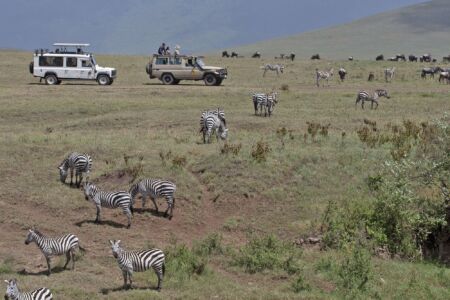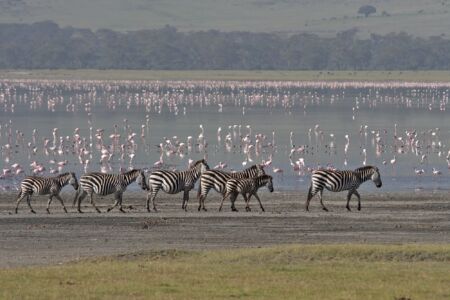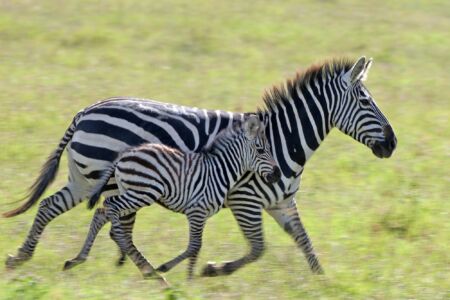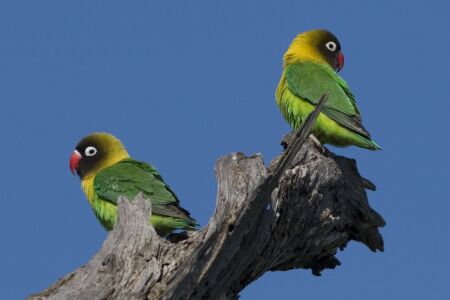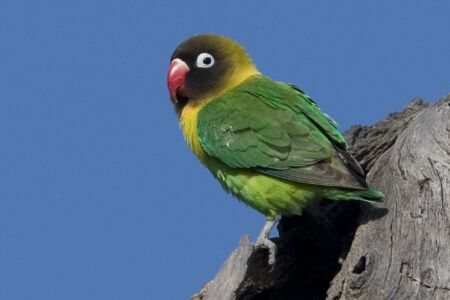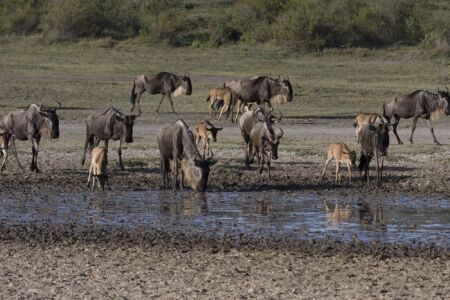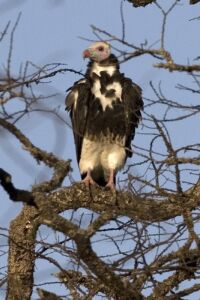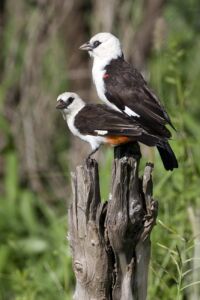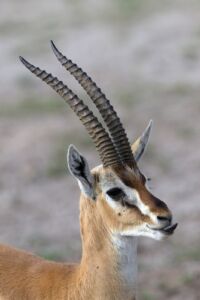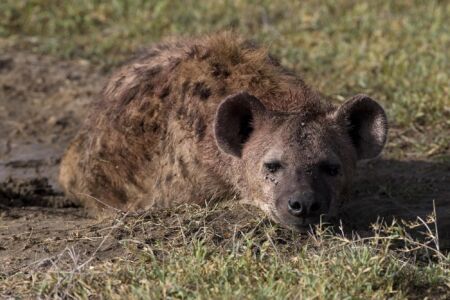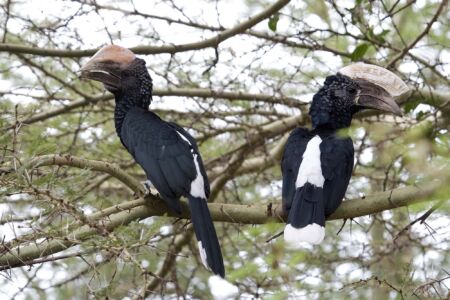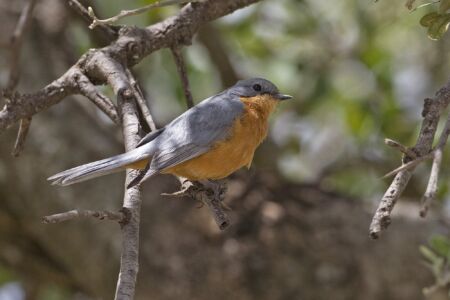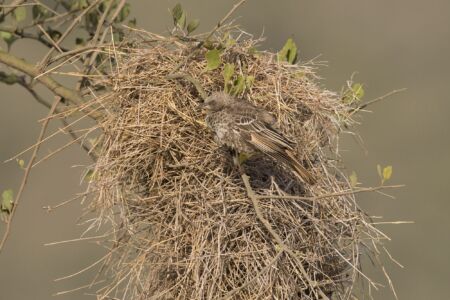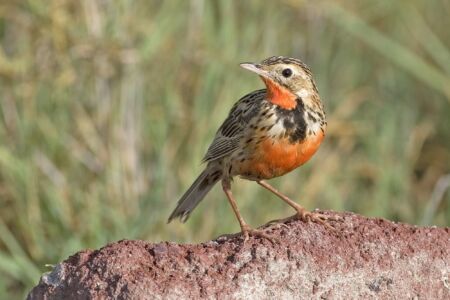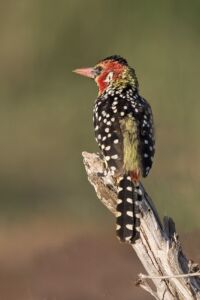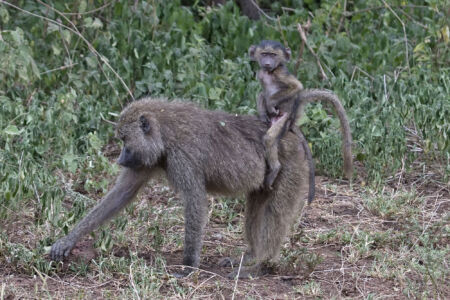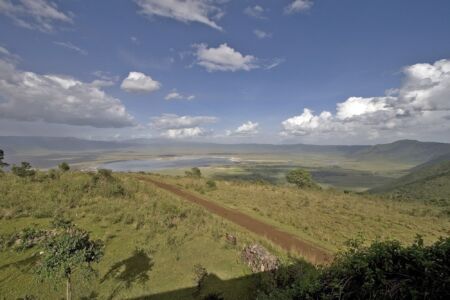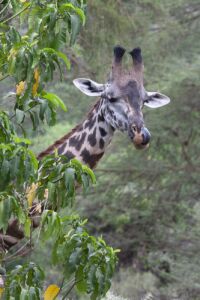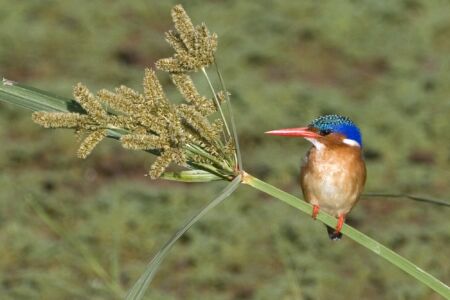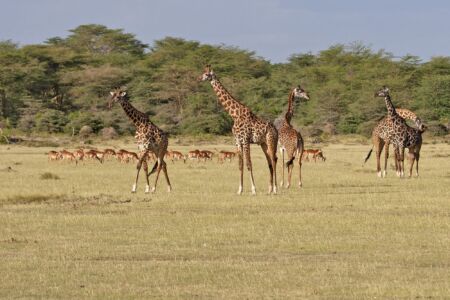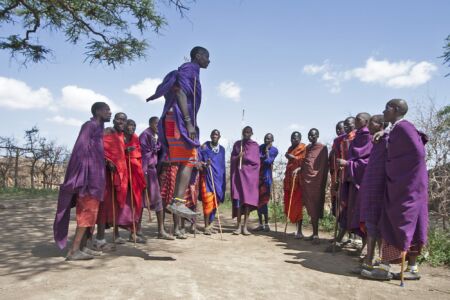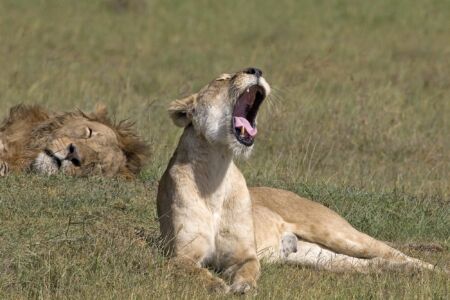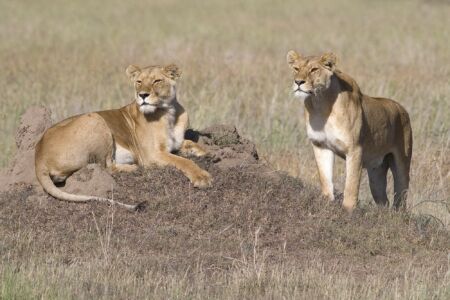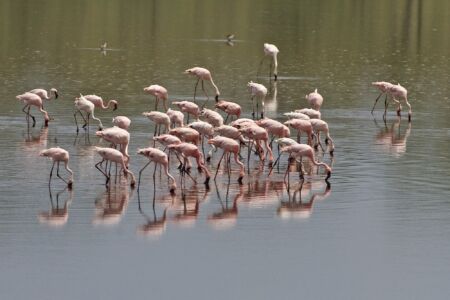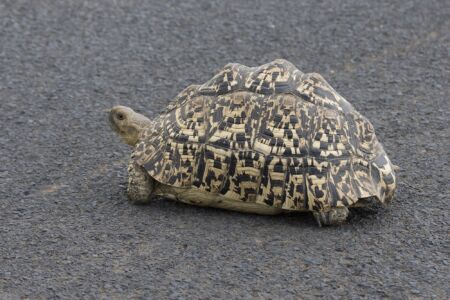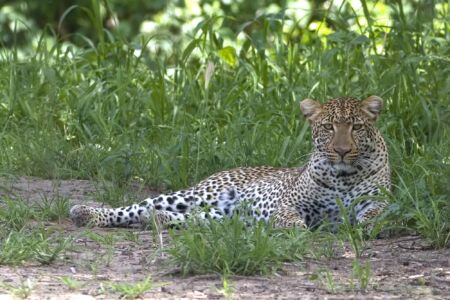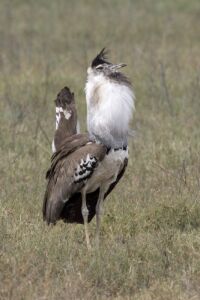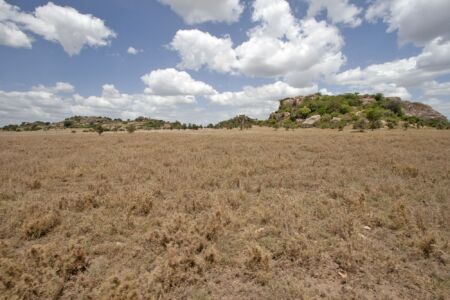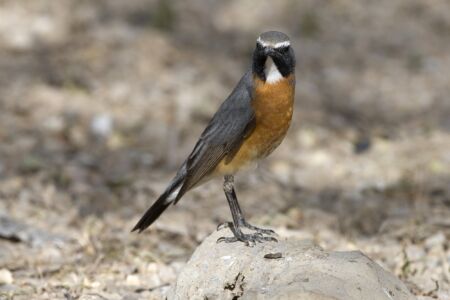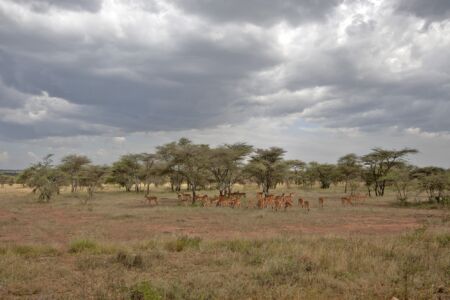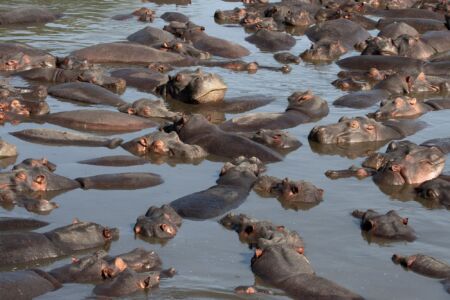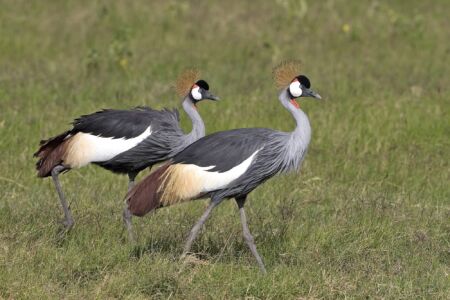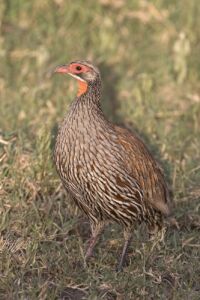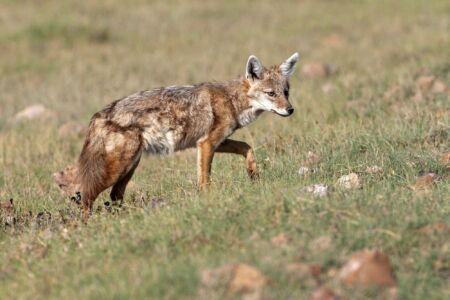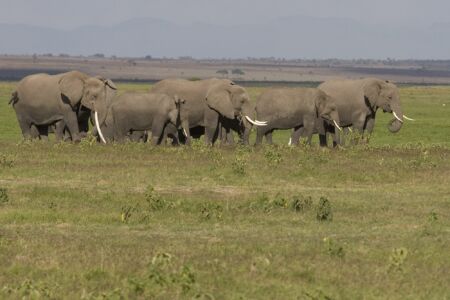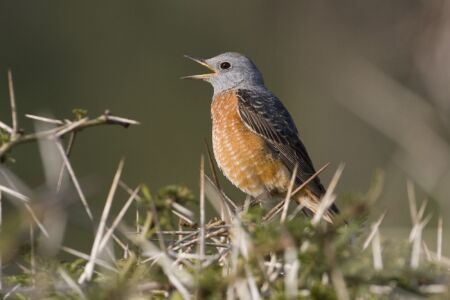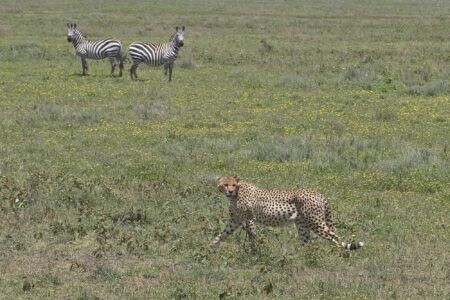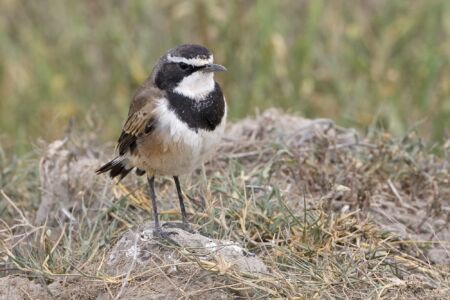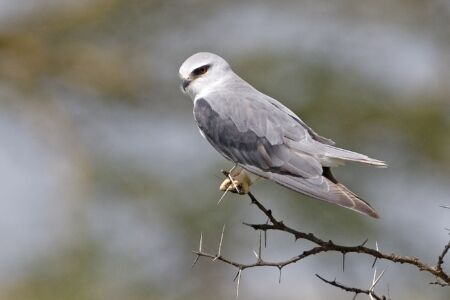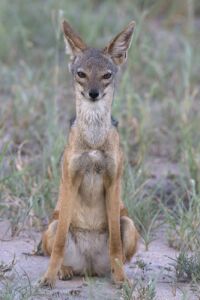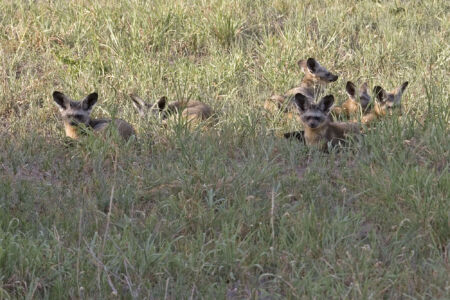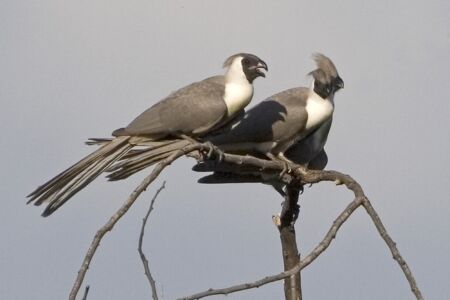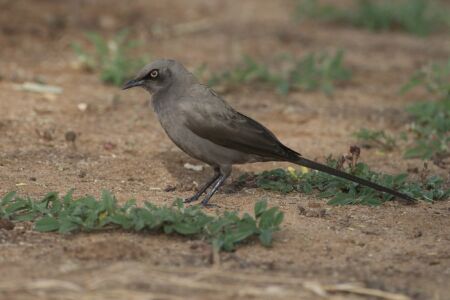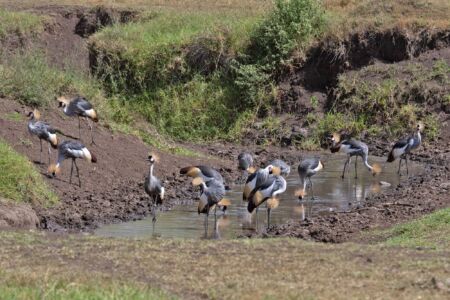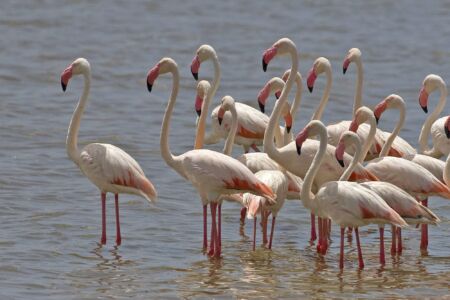TRIP REPORT: TANZANIA – 2008 Feb-March – Wildlife Safari

TOUR FOCUS
TRIP LEADERS
PRIVATE TOUR OPTION
This tour is available as a private trip for any size group. The tour cost will vary with the number of people and any custom requests.
TESTIMONIALS
Trip Report by Adrian Binns
Thursday Feb 21 – Fly into Nairobi
Warren and Diane flew in from South Africa a day early and spent half of today in Nairobi NP, while Ron, Joy and I made it into the Nairobi Serena by 10:45pm, which was about as quick as one could expect considering our late flight arrival. The car park was full of activity mainly from the press that was at the hotel to cover Kofi Annon’s peace negotiations with the countries leaders and want-to-be-leaders, following the reported ‘rigged’ general election.
Day 1 / Friday Feb 22 – Nairobi to Amboseli NP
We all meet for breakfast and heard of Diane and Warren’s encounter with Kofi Annon the previous evening for dinner. It’s a long drive south to Amboseli and we were slightly delayed watching a begging juvenile African Cuckoo Hawk in the car park. Three and a half hours later including a bush break which produced Von der Deckens Hornbills, Emerald-spotted Wood Dove, Hildebrandt’s and Fischer’s Starling, Vitelline Weaver, Slaty-coloured Boubou and a Marico Sunbird as well as a roadside stop for a pair of Pygmy Falcons and Eastern Pale Chanting Goshawk, we arrived in the border town of Namanga. Here we saw a Variable Sunbird and a Jackson’s Golden-backed Weaver putting the final touches to a nest he was building. From here it was onto a dirt road that for the most part was like a washer board and we were soon in the heart of the acacia savannah. Our first Lilac-breasted Roller, that quintessential East African bird was first up followed by a Northern White-crowned Shrike and a pair of Tawny Eagle feeding on something they must have just caught.
We were the only visitors at the park gate when we arrived and were welcomed by a horde of Maasai salesmen. I fancied a spear that I had foolishly passed up 5 months previously and immediately began bartering with one chap. He told me he was “a very busy man” and that I should take it or leave it, at a price of 4 times what I had offered. Busy? There was no one there. I was his only customer and no doubt the next one was somewhere way back on the paved road hours away. I never moved and finally as we began to speed away from the gate the deal was made. By now we were well over 5 hours into our journey and getting hungry, but you know what it is like, there were birds and birds and birds….. We stopped for a pair of Rosy-patched Bush Shrikes , Buff-crested Bustard, Diedereck’s Cuckoo, Taita Fiscals, Ben’s favorite bird Red-and- yellow Barbets and Fischer’s Sparrow-Lark, before deciding that we really better to lunch.
The park is very flat with Grant’s and Thompson Gazelles, warthogs, Zebras and a few Wildebeest on the short grasses and in the areas of wet grasses herds of buffalo and hundreds of elephants in large family groups. The Ol Tukai Lodge is situated on lovely grounds with stately Yellow-bark Acacias with troops of Yellow Baboons and a few Vervet Monkeys lingering just outside the gate this afternoon.
Mt Kilimanjaro dominates the landscape to the south but today it was pretty much cloud covered. Our afternoon game drive was very successful with hundreds of Grey Crowned Cranes dominating a particular area near the Ol Okenya swamp. Thrush Nightingale was seen well near the lodge as was Spotted Flycatcher, Grey-headed Kingfisher, African Grey Flycatcher and Red-billed Queleas. On the open plains Isabelline Wheatears were encountered at regular intervals along with one or two Northern Wheatears. Later we would come across a Pied Wheatear and small flocks of Athi Short-toed Larks and Yellow-necked Spurfowls near shrubby vegetation, while in wetter areas Long-toed Plovers, Spur-winged Geese, Intermediate Egrets, Yellow Wagtails and an African Fish Eagle. We did manage a couple of cats, one being a distant lioness and a closer look at a Serval.
As dusk fell over the lodge Dusky Nightjars and bats came out to hunt but soon disappeared into the night.
Day 2 / Saturday Feb 23 – Amboseli NP to Arusha NP
As the first light dawned across the plains silhouettes of elephants were very evident across from our rooms and upon further investigation we could finally see the snow covered flat peak of Kilimanjaro, much to the delight of everyone. While loading up the vehicle a Grey Woodpecker, Upcher’s Warbler, Red-faced Crombec and Beautiful Sunbird flittered about the tall Yellow-bark Acacias that dominate the grounds. As we moved away from the lodge we encountered a very confiding herd of elephants along with Taveta Golden Weavers a specialty of the wooded areas around the lodge. While looking at the weavers a Winding Cisticola was calling and Buff-bellied Warblers could be followed as they worked their way through the thorny acacia branches, and Water Thick-knees did their best to stay inconspicuous as the rested in the shade below.
Making our way towards the Sinet Causeway we encountered our first Double-banded Coursers along with a few Red-capped Larks. Runoff from the surrounding mountains along with underground seeps feed the permanent marshy areas and swamps that are found in the middle of the park. The very short causeway runs through the Enkongo Narok Swamp and here we had wonderful very close views of Black Crakes, African Jacanas, Long-toed Plovers, Fan-tailed Widows, Wire-tailed and Lesser-striped Swallows, Three-banded Plover, Wood Sandpiper and the stunning diminutive Malachite Kingfisher. We also spotted Red-throated Pipits, African Spoonbills and Isabelline Wheatear before moving along the marsh towards the Lake Amboseli. The track took us close to Red-knobbed Coots, a sleeping Fulvous-whistling Duck, Squacco Heron, Eurasian Marsh Harrier, Plain-backed Pipits and hundreds of Red-billed Queleas.
The lake, which takes up a large part of the park, was dry at this time of season and this enabled us to take a short cut through the lake bed to the Namanga Gate.
From here we worked our way towards the main road stopping for a Brown Snake-Eagle, a pair of Tawny Eagles feeding besides the road on a Scrub Hare and a large flock of Helmeted Guineafowl. We reached the Tanzanian Border at 10:50 and proceeded with the Kenyan exit and Tanzanian visa formalities; switched vehicles to a Land Rover and 40 minutes later were on our way to Arusha.
It took us an hour and a half to reach Arusha as we made the steady climb into the hills and then another half hour to work our way through the town’s main road that was bustling with life, to get to the Serena Mountain Village Lodge for lunch. Situated at an elevation of 8600 feet, Olive Pigeons were perched amongst the lovely gardens flowering trees; Bronze and Black-and-White Mannikins fed on low flower seeds and Amethyst, Eastern Olive and Collared Sunbirds were visitors to the blooming flowers.
It was a short drive from lunch to the Ngurdoto entrance gate to Arusha National Park. Here we were greeted by a Yellow Bishop, Stonechat and Red-billed Oxpeckers before making our way into the park. We took the road leading to the Ngurdoto Crater rim through some dense forest habitat coming across a few Scaly Francolins along the edge. We watched a Mountain Buzzard move from one perch to another and got
up close to a Long-crested Eagle. A pair of Brown-breasted Barbets was a nice find. High in the tree tops on a snag we watched a Kendrick Starling and White-eared Barbet with a Montane Oriole moving about below it. The large Silvery-cheeked Hornbills were conspicuous in trees that overhung the road and the forest is a perfect place for primates. We were not disappointed as we came across Syke’s Blue Monkies and later a small group of Black-and-White Colobus.
At the Mikindu view point we alighted from our vehicle and took in the 3km view across the crater. It was mostly forested with an area of marsh below us. Buffalos could be seen below and the surrounded trees produced African Dusky Flycatcher, Grey-backed Camaroptera, Montane White-eyes and a Peregrine overhead. Heading back Ben spotted a Narina Trogon and after a little patience we could all see it. A couple of Mountain Wagtails were moving along a mountain stream and a Three-streaked Tchagra put in a brief appearance.
Just before sunset we settled into the Ngurdoto Mountain Lodge and while at dinner we were accompanied by half a dozen sleepless Red-winged Starlings in the open sided restaurant!
Day 3 / Sunday Feb 24 – Arusha NP to Tarangire NP
Marabou Storks spent the night on the lodge roof along with a pair of Grey-crowned Cranes and the deep hoots of three Verreaux’s Eagle Owls could be heard on the grounds. The short walk down the road to breakfast produced a White-eyed Slaty Flycatcher and a Red-headed Weaver nest building. By the time we were having breakfast dawn had broken and Mt. Meru was clearly visible. On the lawn, or was it a poor excuse for a golf course, the first of several White-naped Ravens were seen along with Speke’s Weavers building nests under the fronds of a young palm tree. Returning to our rooms prior to checking out, we all watched the beautiful Red-headed Weaver as it flew a short distance to pick up a strand of plant leaf to put the finishing touches to the inside of its nest. Sunbirds were very busy nectaring on a bottlebrush and these included Variables and Bronzy.
We left the lodge about 9:15 and made a stop to pick up Tanzanian shillings in the town of Arusha, which for trivia buffs, just happens to be the half way point between Cape Town and Cairo. We would find out as we went along that this was probably unnecessary as Tanzanians did everything in dollars and seemed bewildered when we asked to convert into shillings. We slowly dropped down in elevation and across the migration corridor between Tarangire and Manyara, seeing Long-crested Eagle, a small flock of Abdim’s Storks and an east African endemic, the Grey Helmeted-shrike. Just after making the turn to Tarangire and getting on a dirt road we picked up our first endemics. While looking at a Brown Snake-eagle, several Yellow-collared Lovebirds alighted on a pylon. This was soon followed by Ashy Starlings, our second endemic and by the time we got to the lodge and into the park both these species were all over the place. One stop before the gate at a huge Baobab tree produced Yellow-breasted Apalis and Banded Parisomas. We reached the gate at 12:30. It took a while to get our fees processed but in that time we watched European Bee-eaters overhead and had Olivaceous Warbler and Upcher’s along with a couple of Grey-backed Camaroptera ‘s. Our vehicle was also sprayed as a preventative against the tsetse flies in the areas.
It was only a short drive to the lodge and once we had taken in the impressive view of the park from the patio, overlooking the dwindling Tarangire River we were shown to our tents before heading to a late lunch. This was interrupted a number of times with Bateleurs; Lappet-faced and Ruppell’s Vultures, Tawny Eagles and Red-necked Spurfowl and Von der Decken’s Hornbill by the swimming pool. Even though temperatures reached 90 we found a fair bit of activity around the tents. A Kirk’s Dik-dik was quite happy resting besides one of them. Cordon-blues were feeding amongst the short grasses and it gave us a chance to see the differences between both Red-cheeked and Blue-capped. A Cardinal Woodpecker was very obliging on a short shade tree and even picked out a half inch grub. On a dead tree Yellow-collared Lovebirds were eyeing up several cavities one of which was occupied by a Grey Woodpecker and another by nest building
Swahili Sparrows. Around the patio we found 3 weaver species, Black-necked, Lesser Masked and Vitelline’s. A juvenile Brubru appeared out of nowhere and perched in front of us. It took awhile to get to lunch!
The undulating landscape at Tarangire, much of it semi-arid, is dominated by acacias and baobab trees, the later a favorite haunt of the Mottled Spinetail. Cutting through the park from south to north is the Tarangire River, and it was along this northern section of the river that we concentrated our efforts this afternoon. A handful of Doum Palms, in which African Palm Swifts nest, line the very scenic rivers banks and in one marshy area 5 Common Snipe feed along the edge and bathed in the shallow open water while further down the river a male Saddle-billed Stork flapped about while desperately chasing a water snake. Other birds included Meyer’s Parrots, Magpie Shrikes, Grey as well as Red-billed Hornbills, Lilac-breasted Rollers, Bare-faced Go-away-birds, Red-and-Yellow Barbets, Striped Kingfisher, Black-faced Sandgrouse and the well camouflaged Bronze-winged Coursers.
There was a bull elephant in musk that we watched from a safe distance. Common Waterbucks and what looked like a sub species of the Southern Reedbuck were on the sandy patches besides the river. At one small pool there was an awful lot of splashing about caused by a young Nile Monitor chasing fish, which in turn had a Green-backed Heron not only excited at the prospect of an easy meal but also having to keep alert that it would not get too close to the monitor. Herds of Impalas, some being bachelor herds and others a male and harem were a regular sight and there was a large troop of Olive Baboons feeding in tall grass. On a small knoll, close to the track we could just see the backs of a sleeping pride of lions. They had a few very young cubs with them which would occasionally show themselves as they moved from one female to another.
Day 4 / Monday Feb 25 – Tarangire NP
The night was full of the sounds of the bush with a lion roaring, African Scops Owl, Pearl-spotted Owl and near dawn Southern Ground Hornbills calling.
We spent the day in the park with a morning and an afternoon game drive both of which produced some wonderful sightings. We had 3 species of parrots, the ubiquitous Yellow-collared Lovebirds, a few Meyer’s and good numbers of Orange-bellied. Shrikes were numerous with Magpie Shrikes and Northern White crowned outnumbering Common and Long-tail Fiscals, though the best one may just have been the Brown-crowned Tchagra that we watched when we finally found a perched European Bee-eater. We came across a large group of Red-billed Buffalo-Weavers feeding in the grasses and saw a few at their stick nests. A pair of Red-faced Crombecs and a Tawny-flanked Prinia were our only warblers while Mottled Spinetails and an African Golden Oriole were their only family representatives. Diane spotted an African Harrier Hawk deep in the middle of a tree and other raptors included Bateleur, Augur Buzzard, Pale Chanting Goshawk, Tawny Eagle, Lappet-faced Vulture and a few African White-backed Vultures, just some of the almost 50 raptor species that been found in the park.
After watching a lovebird feeding on the ground we rounded a corner and found a Leopard resting in the shade 30 meters away. What a beautiful sight as it looked right at us mindful that we were keeping our distance. It was not the leopard in the tree scenario that all were expecting, but we could not have asked for a better look. What a way to end the morning session.
A species that is heard on a daily basis in this part of the world is the Red-chested Cuckoo, but trying to actually see it can be tough. One was calling around our tents and while checking out a Nubian Woodpecker and party of Arrow-marked Babblers it was finally located near the top of a Baobob tree.
Totilis Acacia, Balanites and Baobabs make up the majority of the vegetation that is found in this northern
section of the park and this afternoon we tried our luck on the Lemiyoni Circuit. We began with a Grey Hornbill making two visits to its nest hole to feed its mate through the narrowest of slits – an extraordinary event to witness, knowing that she sealed herself in for the duration of incubation.
A group of 7 Senegal Lapwings gave us a chance to work out the identification separating this species and Black-winged. We were hoping to cross a dry sandy river bed but came across a diesel laden truck and 2 land cruisers stuck in the river bed! We decided it was best not to try, but we did help some of the others. 15 minutes later our Land Rover had pulled the 2 cruisers out and did not even bother attempting the truck. No doubt it would be there for many more hours if not days!
We turned back and had a number of Two-banded Coursers and Chestnut-bellied Sandgrouse as well as having to contend with a few Tsetse flies. 3 Secretary Birds were later seen along with a pair of White-bellied Bustards wandering the grasses in search of a late day meal. More relaxed were 6 Bat-eared Foxes sitting in a tight group watching us. Though they seemed perfectly happy, they all of a sudden just got up and ran away. Our last mammals at dusk were a pair of beautiful Black-backed Jackals that seemed to want to hang around the vehicle. The skies had darkened considerably by the time we got back with a thunderstorm fast approaching from the west, but somehow what I expect would be our first rains of the trip missed us.
Day 5 / Tuesday Feb 26 – Tarangire NP; Gibbs Farm; Ngorongoro CA
A check of the birds around our tents at first light produced a Spotted Morning Thrush and Grey-headed Kingfisher while near the car park there was a pair of Beautiful Sunbirds hanging on their drooping nest situated a couple of feet above the grasses and Crimson-rumped Waxbills feeding in the grasses.
The drive out of the park gave us further looks at Rufous-tailed Weavers and an African Mourning Dove as well as a small group of iridescent Green Wood-hoopoes and what was becoming a familiar sight, Eurasian Rollers.
From the main gate we headed north and then took the only road west, that would eventually lead us to the Ngorongoro Crater and then into the Serengeti. Our goal was to get to the Gibbs Farm for lunch but before that we made two stops along the way. First at a local school to deliver pens to the school kids and then to a road side T-shirt shop, billed as Tanzania’s finest T-shirt shop!
The Gibbs Farm is set 5km off the road in the central highlands and we paid a visit for a few hours that included a wonderful home cooked lunch and a remedy for Ron’s stomach that the chef guaranteed would work (for a fee). The problem was that Ron took the medicine but never paid the “good doctor’s” fee. The farm was started in the 20’s by a German family as a coffee plantation and to this day that continues. As tourists began to head to the Seregenti in the 70’s they expanded with accommodations and a wonderful garden full of flowering plants.
The welcoming committee proudly showed off a Side-striped Chameleon in the car park and we soon got to grips with Bronzy Sunbird, Baglefecht Weavers and African Paradise Flycatchers, of which we later found at a nest, Streaky Seedeaters, Rock Martins, African Citril Finch, Red-billed Firefinch and White-tailed Blue Flycatcher. In the small cattail pond by the gift shop several Grosbeak Weavers were in attendance at their nests. These are the finest and tightest built of the weaver nests and are usually found about 3 feet above the water line. The most elusive of the garden birds was a Ruppell’s Robin Chat that we only got glimpses of as it flew.
It’s only a short drive to the Ngorongoro Crater from the farm. There was the obligatory stop at a view point at the top of crater which left us in very excited knowing that we would be ‘down there’ tomorrow. Nyanza
Swifts patrolled the edge and between here and our lodge we stopped at Michael Grzimek’s rock grave site. He along with his father was responsible to putting the Serengeti and Ngorongoro Crater ‘on the map’ and helping to keep it preserved. One last bird on the rim, a Cinnamon Bracken Warbler darted low across the road and into the brush, before we made the last turn towards the Ngorongoro Serena Lodge. We paused here to take a picture of the Serena sign only to have an irate elderly Maasai gentlemen in his traditional chequered red clothing come running down the hill waving his spear at us, as he thought we were taking his photo. In all honesty he was in the background but it really was not him that we were photographing. He buzzed the vehicles open windows checking our cameras as we showed him our (blown up) images of the sign (of course). Even Ben’s efforts to convince him were meeting upon deaf ears…….we moved on. Minutes later we were in awe at the location of our lodge. Situated right on the craters rim the view into the crater with Lake Magadi being the most visible landmark, was simply stunning.
With a little time to spare and hoping that we would not get rained on we walked around the entrance to the lodge. A Cape Robin Chat was very confiding feeding on the ground while the skies were patrolled by Abdim’s and White Storks, a Great Sparrowhawk and a Martial Eagle, though the raptors always seemed to be flying away from us! In the end we found a Dusky Turtle Dove that would at least cooperate and sit for us while smaller birds included Yellow-Crowned Canary, African Dusky Flycatcher and Brown Parismo.
The evening’s entertainment at the lodge prior to dinner was a short affair by local acrobats held in the lounge. It was more like a cross between gymnastics and break-dancing. It was a shame that our stay would not be long enough to see the Maasai dancers in a few nights.
Day 6 / Wednesday Feb 27 – Ngorongoro Crater
It was one of those days. Would the anticipation of what we would come across in one of the world’s most famous natural wonders meet all the hype? Our one and a half days in the Ngorongoro Crater certainly lived up to all expectations. From about 7500’ we descended the crater wall to the vast open plain 2000’ feet below. The view this morning was outstanding and we were able to take it all in when we paused for Scaly Francolins and Schalow’s Wheatears on the way down the Seneto descent road. Nearing the bottom of our slow descent to the crater floor we came across our first really good looks at Rufous-tailed Weavers attending to their nests and Northern Anteater Chats.
The crater rim is 18 by 20 kilometers across and the floor has tracks that criss-cross almost all of the plain and wherever we went there was always wildlife in view as well as a 360 degree panoramic view of the surrounding crater walls. Lake Magadi, the soda lake, dominates the plain in the wet season and is covered with a hundred thousand Lesser Flamingos, and a keen eye is needed to pick out a handful of Greater Flamingos. There are a few fingers of forests that can be found along narrow rivers and streams that descend from the rim, the largest of which is the Lerai Forest, yet it is smaller is size than the lake. Two swamps, Mandusi and Gorigor, give elephants a chance to cool off in the heat of the day and hold an assortment of waterbirds, though close access, other that at the Ngoitokitok Springs picnic site where we had lunch, is not possible.
As we drove the well maintained tracks diminutive Zitting Cisticolas were a constant reminder that with a great many East African birds, the smaller the bird, the louder the call. Grassland Pipits, Yellow Wagtails, Rufous-naped Larks, Fischer’s Sparrow Larks and a few Capped Wheatears as well as the ubiquitous Abdim’s Storks and White Storks were seen at regular intervals in the short grasses along with Montagu’s Harriers quartering the plains. Small bodies of water attracted a variety of bird life including Cattle Egrets, Long-toed Plover, Temminck’s and Little Stint, Curlew Sandpiper, Gull-billed Tern, Great White Pelican, Common Snipe, Red-billed Teal, Hottentot Teal and even a Northern Shovelor, while hippos could be seen partly submerged at the aptly named hippo pool. Our track took us along a narrow strip of vegetation besides the Munge River (more like a stream) where we came across Little Bee-eaters, Dusky Turtle Doves and three cuckoos, Diederik’s, African and Jacobin.
As was the case with many of the visitors in the crater we had our boxed lunches at the Ngoitokitok Springs picnic site. Here we were allowed out the vehicle, used the facilities, and were joined for lunch by scavenging Yellow-billed Kites, Rufous-tailed Weavers, Helmeted Guineafowls and Speke’s Weavers. The later squabbling over the best spots along the rim of our pop-up roof Land Rover waiting for the right opportunity to snatch a bread crumb or two. The adjacent freshwater lake held Purple Heron, Long-tailed Cormorant, Red-knobbed Coots, Spur-winged Geese, Lesser Swamp Warbler and Fan-tailed Widows.
Mammals were everywhere, though most were grazers such as the Warthogs, Wildebeest, Zebras, Grants and Thompson’s Gazelles, which we often parted as we drove through a group of them. There were certainly plenty of others to keep us enthralled and we stopped often to admire them and witness this smorgasbord of mammals. Golden Jackals always on the lookout for a quick meal; Spotted Hyeneas chasing after a herd of fleeing Wildebeest which had a few young calves amongst them got our adrenaline up as we hoped to witnessed our first ‘kill’, but alas the undulating terrain and track that we were on meant that we lost the action for a few minutes and would never find out why the hyeneas were unsuccessful. On a rocky outcropping we could see lions sleeping though occasionally a cub could be seen moving about. A male did get up and from our view point it looked as though he was mating. We would later come across a second pride with cubs and this time they were right near the track with the male only feet from us. Buffalos, with Yellow-billed Oxpeckers on their backs, seemed to keep to themselves and though this is one of the last strongholds of Black Rhinos in East Africa we only got to see one, wishing that it had been walking towards us and not away.
Two stately bird species graced the plains. Grey-crowed Cranes mostly in pairs and the crater must surely be the site to see Kori Bustards. We saw no less than a dozen including one displaying, his white neck feathers fully inflated and his tail pointed to the sky showing his white undertail feathers that could be seen at a great distances. We could hear his very deep and low ‘pop’ as he called.
By late afternoon we slowly wound our way around the Lerai Forest dominated by beautiful and tall Yellow-bark Acacias and Croton trees. Here we had good looks at Brown-crowned Tchagra, Chin-spot Batis, White-browed Coucal, Olive Pigeons and a Common Buzzard before slowly making our way up the ascent road.
Once on top of the crater rim we watched Jackson’s and Red-collared Widowbirds flying back and forth amongst the grasses in the lush moorlands and capped off the day working hard to locate one of two Schalow’s Turacos that flew across the road. It called from the back side of a tree which made it (slightly) easier to locate this brilliantly colored bird that blended in so perfectly.
Day 7 / Thursday Feb 28 – Ngorongoro Crater; Oldupai Gorge; Ndutu area
As we opened the doors to our rooms before dawn we could the deep hoots of Verraux’s Eagle Owl and the trilling of Hunter’s Cisticolas. The day was young but the excitement of a return visit to the crater was very evident amongst us.
New today was a Rock Thrush on the descent into the crater; 2 Hobbies, one of which had just caught a lark on the crater floor along with an Isabelline Shrike, Martial Eagle with prey and Yellow-billed Duck, and on the ascent a Yellow Bishop and a pair of Cinnamon-chested Bee-eaters. As nice as those were it was certainly a big cat morning with sightings of a pair of lions, two separate Cheetahs and a Several.
Working our way around the crater floor we watched nervous Wildebeest run as Spotted Hyeanas loped towards them but all was in vain as the eleven hyeanas seemed more interested in greeting each other. Our first cats were a pair of mating lions! We arrived on the scene as the two were sleeping with the female on her side with a leg in the air. 10 minutes later she got up and the male immediate arose. She crunched down
if front of him and the male mounted her. Seconds later, 13 to be precise, and it was over. She walked about 15 meters away with him following right behind her and she just dropped to the ground and fell asleep and he did the same. The routine will go on for several days at about 15 minute intervals. This was very likely the same two that we saw on the outcropping yesterday. It’s good to be the king. I did notice that his ribs were visible leaving me to believe that in all likelihood he had not eaten in a number of days and that this female was not the first one in the pride he was mating with at this time. All the mature females in the pride come into heat in succession and his job is to make sure that his genes are the only ones that the females have access to at this time.
We could see a congregation of vehicles a kilometer away and knew something was going on. It turned out to be a Cheetah busy eyeing Thompson Gazelles 400 meters away. After a herd of wildebeest passed in front of her she got up and began a slow measured stalk for about 80 meters and sat down. She knew she was far too far away and the Tommies knew danger was in the air, but at least not within striking distance. We did not wait to see what the outcome of this chess match would be. The smallest of today’s cats was a Serval. No slouch in the hunting department this avian striker was busy looking for a mid morning meal wandering about the mid height grasses with determination.
We again came across a Black Rhinos but this time it was sleeping and once again not as close as we would have liked. As we worked our way toward the Lerai ascent road we came across a lioness on one side of the road and a male sleeping in a culvert on the other side. We were able to pull right next to him and looked down on his shaggy mane that covered most of his head. This strange pose made him look like something out of the Wizard of Oz bringing to a close our magical experience in this natural wonder.
While back at the lodge for lunch and loading our bags we got to see Yellow-bellied Waxbill, Brown Parisoma, Hunter’s Cisticolas and Eastern Double-collared Sunbirds.
From the Serena it was a 45 km drive down the mountain and into the plain before reaching Oldupai Gorge. Stopping at the Museum, the few bushes on the edge of the gorge held Red-billed Firefinch, Speckled-fronted Weavers, Slaty-coloured Boubou, Rufous Chatterer, Vitelline Masked Weavers, Swahali Sparrow, molting Black Bishops and the much sought after Irania (or White-throated Robin). The museum gave as an overview of the history behind the Leakey’s excavations and finds that unraveled much of mankind’s past, and is situated on a small escarpment overlooking the most scenic part of the gorge. We paid a short visit to an excavation site before moving along the northern side of the gorge to the Shifting Sands site. This small sand dune about 40 square meters in size has been moving along this short grass plain at a noticeable rate over the years. Small white markers lay claim to where it been at a certain time, but the dates were tough to decipher.
We were now along the invisible boundary between the Ngorongoro Conservation Area and the Serengeti National Park heading towards Lake Ndutu which is just within the Serengeti. The wind swept across the open plain making it very dusty. A late afternoon storm brewing in the distance darkened the skies but did not affect us. We passed dozens of Maasai shepherds with hundreds of goats each and wondered why in the modern age, lessons learnt about the destructiveness that these domestic animals cause to the native vegetation had not been passed on. Scores of Thompson’s and Grants Gazelle were in front of us and the storm produced a beautiful double rainbow. The open habitat was perfect for Red-capped Larks, Temminck’s Coursers and many Chestnut-bellied and Yellow-throated Sandgrouse, all of which we stopped to admire, while on acacias Eastern Pale Chanting Goshawks perched waiting for a bird, rodent or hare to pick off. We also had our first Great-spotted Cuckoo seen looking for lizards and insects as it walkied the short grasses.
We arrived at our mobile tented camp situated along the riverine embankments of the Oldibai River that feeds into Lake Ndutu at 6:45pm. Though the accommodation were basic and adequate the meals that the camp cook provided were excellent.
Day 8 / Friday Feb 29 – Ngorongoro Conservation Area and Serengeti: Ndutu area
The evening in the bush as one would expect was full of activity with hyenas and lions vocalizing near the camp. The dawn chorus started early with an endless chorus of Ring-necked Doves cooing ‘work harder, work harder’. A pair of Red-throated Tits, Brubru and a Yellow-breasted Apalis showed well around the camp before breakfast along with several Fischer’s Lovebirds.
We ventured out into the Conservation Area adjoining Lake Ndutu for nearly 5 hours, coming across Eurasian Roller, Chestnut-bellied Sandgrouse, Red-billed Buffalo Weavers, Grey-breasted Spurfowls and White-bellied Canaries while at one stop we had Black-faced Waxbill, Silverbird, Marico and Beautiful Sunbird, 2 Abyssinian Scimitarbills and a pair of Greater Honeyguides. Not too far away a Dark-chanting Goshawk posed nicely on top of an acacia bush. Our mammal sightings were excellent with Giraffes, Elephants, hyenas, Black-backed Jackal, a pregnant cheetah laying in the shade besides the track and hundreds of Zebras that had migrated into this area. We spotted a large group of vultures circling and soon found them descending to a kill. They had just displaced 3 Cheetahs who wandered over to the shade of an acacia totillis to lie down and digest their meal – a wildebeest calf. After watching the cheetahs settle down we drove the short distance to the vultures and found 3 species, Lappet-faced, African White-backed and Ruppell’s cleaning up the carcass.
In the heat of the day we heard a Pearl-spotted Owlet calling and Ben called it right in besides our vehicle. At Lake Masek, another shallow soda lake, which is actually where Olduvai Gorge starts, Lesser Flamingos were busy swinging their bills from side to side as they fed on blue-green algae. There were also a dozen wildebeest stuck in the muddy water with no hope of making it out alive. Some had their calves besides them, but unfortunately they also will be doomed without their mothers able to feed them. Just before the entrance to our tented camp we watched a Serval walking amongst the taller grasses before it decided to hunker down.
We had a wonderful lunch in the mess tent while the skies darkened as a storm approached somehow dodging the rain. From our tents we looked out across the mainly dry river bed and over the woods seeing a White-headed Vulture soaring. As we wound our way through the open acacias, the afternoon game drive began with Double-banded Coursers, a Gabar Goshawk and 3 Secretary Birds including a juvenile and one sitting atop a shrub, Plain-backed Pipit, a small party of Black-lored Babblers, African Hoopoe and Green Wood-hoopoes. The common hornbill in this area was Von der Decken’s. The last remnants of recent rains held Common Ringed Plover, Marsh Sandpiper and Kittlitz’s Plovers.
Serengeti means endless plains and once we had reached the open plains we could see that it was appropriately named. In the distance we could see wildebeest stretching across the horizon almost 180 degrees. This is their annual migration following the green grasses and the rains as they head north at this of year -amongst them many zebras, Grants and Thompson’s Gazelles. Temminck’s Coursers, White-bellied Bustard and a Greater Spotted Cuckoos were also in this area.
Cutting across the riverine habitat we paused for a sleeping lioness in the marsh and watch Yellow-billed Storks, Grey Herons and Black-headed Herons feeding nearby. On the other side a White-headed Vulture afforded us a closer look than the one earlier in the afternoon, as it was perched. As sunset approached Grey-breasted Spurfowls became a more common sight and we came across a pair of reposing Stenboks.
The day ended with a lovely candlelight dinner by the campfire, under the starts in the bush with the staff serenading us with songs of the Seregenti as they presented us with a cake for desert.
Day 9 / Saturday March 1 – Ngorongoro Conservation Area; Ndutu Area – Serengeti National Park
We awoke to Eurasian Nighjars churring and a Blue-naped Mousebirds high pitch single call notes.
We caught a wonderful part of migration this morning as we came across a large herd of Wildebeest most with their calves in tow coming down to the last remnants of pools of water in the mainly dry lake bed to drink before moving on. On the open plains we parted numerous herds of gazelles as we drove through and had good numbers of Lesser Kestrels and Gull-billed Terns hawking insects as well. We even had an Ostrich running besides us at 55kmp before it cut across the track and faded away, pleased that it had outrun us!
We arrived at the Naabi Hills main entrance gate to the Serengeti by 9:30 and watched Yellow-bellied Canaries drinking at a small bird bath along with Rufous-tailed Weavers, Speke’s Weavers, African Mourning Doves and Hildebrandt Starlings. From here we descended down the hill and out into the open savannah that we always think of when we think about East Africa. The endless plains, as is the Swahali meaning of Serengeti, stretched out for as far as one could see. Dotted amongst the landscape were Kopjes, large granite outcroppings with various amounts of vegetation around them. We visited the Simba Kopjes in search of cats and only came up with Isabelline Shrike and Scarlet-breasted Sunbird. Back on the plains there was a single Topi amongst Coke’s Hartlebeest’s and occasionally we would see a Black-shouldered Kite and European Roller. Out in the middle of nowhere a pair of Lioness stood in the midday sun panting. Maybe they had just made an unsuccessfully attempt at a kill.
At Lake Magadi we were treated to a nice flock of Greater Flamingos and Cape Teal and had several Whiskered Terns roosting on the water’s edge. In the adjacent marsh we caught up with Hottentot Teal and had close views of Little Stints and Ruffs. By midday we had visited the Maasai Painting at one of the Kopjes and watched from the high vantage point a massive herd of thousands of migrating Zebras. We had our box lunch besides the Ngong Rocks, named after the metallic sound that resonates from the rocks when tapped with a small rock. Rattling Cisticolas, Fischer’s Lovebirds, Red-capped and Rufous-naped Larks, Fischer’s Sparrow Larks and Grey-backed Shrikes became regular sightings in the afternoon along with a few Magpie Shrikes. Just before the View Point picnic area, which produced a Silverbird, there were 4 Hyaenas under a tree that lifted their heads from their sleeping positions as we turned a corner. The remainder of the afternoon had us watching another pair of Lioness’s trying of enlargen a hole that we all thought more than likely had a Warthog in. While waiting for ‘action’ we had a roller and Black-shouldered Kite land in a dead tree, the latter with a rodent, which it proceeded to tear apart and devour. We spent about half an hour waiting for the lioness to dig out the warthog before moving on. We later leant that it was another hour before a warthog did indeed come running out the burrow only be meet its demise at the hands of the lioness less than 10 meters from its home. Of note was a nice size group of Bohar Reedbuck in a nearby marshy area. By 5:30 we had reached the beautifully situated Serena Lodge and settled in before dinner and a show of traditional dances. A quick check of the gardens yielded Marico Sunbirds and Bare-faced Go-away-birds.
Day 10 / Sunday March 2 – Serengeti National Park
Arrow-marked Babblers joined us for breakfast just as the sun rose looking for any scraps and crumbs amongst the outside porch tables. We had two sessions in the park today, beginning with our morning game drive. Grey-breasted Spurfowls were often seen walking about besides the dirt roads and we had our first good look a Ruppell’s Long-tailed Starlings. A couple of stunners followed with Golden-breasted Bunting and Steel-blue Whydahs in full flowing plumage but even that could not match the Eastern Paradise Whydah. We would watch two males displaying as they flew across the road and into the brush obviously trying to impress a female with their long ‘rooster’ like tails. At this same spot the rarely encountered Pangani’s Longclaw showed well and a little further way a Secretary Bird was on top of an acacia bush attending to her nest. While watching Mosque Swallows and separating them from Red-rumped Swallows we had flocks of Chestnut Sparrows and Grey-capped Social Weavers looking for nesting materials and Cutthroat Finches alighting on the track, but the highlight surely had to be a displaying Flappet Lark.
It took off from the grasses on one side of the track rising slowly snapping its wings then dropping and disappearing into the grasses on the other side. This was followed with Silverbird, Usambiro Barbets, White-browed Coucal, Rufous Chatterer, Magpie Shrikes, Fischer’s Lovebirds, Green Wood-Hoopoes, Blue-naped Mousebirds, Red-faced Crombec and a Red-backed Shrike. Beside a small pool 3 Black Crakes were busy working the marsh edge.
The Hippo Pool was extraordinary, not just because we were able to get so close but for the sheer number that were in front of us – at least 150 of all sizes. Most were resting or sleeping, some had young calves even as young as a few days old and one or two were out of the water. Occasionally there would be a ruckus and teeth would snarl and a few would jostle around while most of the group would grunt their displeasure, which was quite humorous. At least two had recent wounds, some with blood, created by the tusks of an unhappy neighbor. Occasionally the tail of one hippo would swing from side to side as it defecated, spraying dung in either direction – no one seemed to mind! A couple of Nile Crocodiles, one of which was massive, lay at the far end of the pool and ignored the whole proceedings though had the Vervet Monkeys inched any closer to them I am sure we would have seen a croc lunge at them for an easy meal. Mottled Swift and Sand Martins were added to the list here.
Back at the Serena for lunch, Striped Pipits were feeding near our rooms and a few birds came into the bird bath for a drink, most being Bronze Mannikins. A small party of Banded Mongoose also paid a visit but the most exciting was to find that they had killed a Puff Adder and one dominant one wanted it all for himself. The sunlight on Ruppell’s Starling meant that they were seen in their full glory, turning a dark bird into vivid iridescent shades of greens and blues.
I called the afternoon session the “B” game drive as it seemed we had a bunch of B’s. Firstly, bad luck as we failed to avoid a barred Flap-necked Chameleon in the road, then a big black cloud covered the Seregenti and in the ensuing storm we had to change a balding bad tire. Our encounter with a large herd of Elephants was exciting as it began with a bull trumpeting and charging to put himself between the family and the few vehicles that were there. One mother had a new born baby with her that was so small. More “B’s” ensued – Black-bellied Bustard, Black Crake, Black-shouldered Kite, and then a group of 3 Bat-eared Foxes followed by one of 5. Continuing along, we encountered a very agitated troop of Black-faced Vervet Monkeys making alarm calls. This seemed to be because a number of babies had dispersed into the grass, maybe because they had just seen danger, but it did not stop a number of them from continuing their lookout from the tops of trees. That was not the end of the “B’s” we had a Bohor Reedbuck in a marshy area and found an astonishing 3 Black Coucal’s perched in the open following the brief rains. These are usually so secretive, so we were lucky. Indeed we were……. as dusk set and we were making our way back to the lodge, there was a wonderful encounter with a female Leopard right next to our vehicle. The tall grass made it even more special as she emerged only meters away and came straight at our vehicle before crossing the track between our vehicle and the one in front of us, pausing on a small berm to check out the surroundings. The vegetation was thick and in likely hood she was expecting to startle or come across something as she hunted.
Day 11 / Monday March 3 – Serengeti to Lake Manyara
This was a long day as we needed to cover a great deal of ground and had an evening game drive at the end of it. It began slowly when Martin found that the straps to hold down the canvas and bags on the roof rack were missing. That meant finding substitutes. Once on the way we paused near the Serengeti Park Headquarters for the only petrel in miles (probably a good idea) and then cut right through the heart of the Serengeti Plains. There were Pallid Harriers quartering the grasslands along with the occasional Black-shouldered Kite, Lesser Kestrel and Kori Bustard. Close to the road we encountered 2 lioness’s on a termite mound eyeing very distant warthogs and buffalo while large flocks of Chestnut-bellied Sandgrouse flew into a nearby pond for their morning drink.
Just the other side of the Naabi Hill Gate there was a Tawny Eagle harassing a female Montagu’s Harrier which had caught a small rodent. Once a second eagle showed she decided that it was best if she just drop it and avoid any further confrontation with them. A good move!
In the shadows of the Ngorongo Mountains we paid a visit to the isolated Kiloki boma or Maasai Village where 152 people lived. In a very small circular area surrounded by acacia branches to keep out marauding lions there were 52 huts no more than 5 feet in height and all made of acacia branches and packed cattle manure. In between layers of the later on the roof were pieces of plastic to aid in stopping any penetrating rains. Our Maasai guide invited us into one of the huts. It was a tight squeeze through the door and dark inside. The circular 10 x 10 foot hut consisted of a living area with a small wood fire to boil water, cook meat and warmth. One half of the area was divided into 2 bedrooms, one for the male and another of the wife and kids! We heard tales of adulthood with rituals of circumsion, killings of lions and that they their diet consisted of milk, blood, beef and animal fat. Once outside the hut there was a horde of local made bead jewelry for sale, most with exorbitant asking prices and a visit to a small open roofed schoolhouse where one very smart 4 year old lead the class in reading the numbers 1 through 20 in English.
Continuing on we past the entrance road to the Olduvai Gorge and began the steady climb up to the Crater rim arriving for lunch at the Ngorongoro Serena by 1pm. The view of the crater floor and lake below was of course stunning and we were glad that we had another chance to see it. An afternoon storm was brewing coming in from the west and we would stay just out of its reaches for the remainder of the afternoon.
Along the rim we paused for a pair of Golden-winged Sunbirds though it was only the female that showed for the whole group. Once through the Ngorongoro Conservation Area gate there was the obligatory stop at the “best T-shirt shop in Tanzania” in the central highlands where we had a Black Bishop, singing Yellow-fronted Canaries and a Green-winged Pytillia next to the hut. From here we descended the escarpment to the entrance to Lake Manyara National Park. We got in several hours of a game drive as we wound our way through very different habitat than we had seen to date. In was a lush forest with streams winding their way down from the surrounding hills and towards the enormous though shallow salt water lake. Yellow-billed Storks were very conspicuous on their nests above the entrance car park and Sykes Blue Monkeys evident along the forest edge. There were many stops along the tracks, firstly for a Village Indigo then an African Crowned Hornbill the first of three species that we would see her, the others being Grey and the impressive Silvery-cheeked. Once through the forest the landscape opened up to very short grass with the marsh and lake beyond that. A few tracks lead us close to the water where we finally caught up with Spur-winged Lapwings! There was nice grouping of Great White Pelicans and the oddly named Pink-backed Pelican. The wind here was howling right in our faces which made for rather unpleasant viewing conditions, however there was a Goliath Heron along the narrow channel and Black-tailed Godwits, a Pied Avocet, Hottentot Teals and Little Egrets feeding in the water amongst a number of Ruffs, Little Stints and Curlew Sandpipers. Basking on the far shore were many Yellow-billed Storks, a few Marabous, Grey Herons and pelicans. Heading back we watched a pair of Giraffes in the throngs of courtship as a dozen other giraffes watched their every move. I am not sure what they learnt as the male followed the female in a continuous winding path that included many stops, a couple of very brief mountings and much false hope. Patience, I guess was the lesson here.
We ascended the escarpment to the perfectly situated Serena. Our time here would be brief as we had less than hour to check in and get to our rooms before heading back to the park at 7pm for our night game drive. Once inside the park we began with an eloquent dining experience in the bush. Being a cloudy evening the dim candle lights on the table added to the ambience. The chef had prepared an assortment of meats, side dishes, salads and desserts. It was a wonderful meal punctuated with alarm calls from nearby baboons, no doubt alerting their troop to a Leopard, and the wailing sounds of Bushbabies.
Following dinner we had 2 and ½ hours of driving the tracks spotlighting the wildlife all to ourselves. Along for the ride was a ranger with rifle (should we encounter any unruly animals), the driver and a spot-lighter. Sitting on a special seat on the left front of the bonnet the spot lighter did a masterful job checking the dense vegetation on either side of the road. We started off with a Small-spotted Genet laying across a fallen log and then the first of what would be at least a dozen Crested Porcupines, the most any of us had seen. One encounter included a small baby that followed its mothers every step which was a magical moment to witness. A Lesser Bushbaby, now known as Galago’s, was next up, seen in the middle of a tree. Then there was a sleeping young male Lion that was stretched out besides the track. Our light disturbed it once or twice causing it to lift its head to see what all the fuss was about. We caught the tail end of an African Civet a little further along but opted to continue to watch the lion less than 20 feet from us. Moving on we soon encountered the Civet, a larger and darker version of the genet. Our second cat was young African Wild Cat which wandered off into the taller grasses. Hippos had ventured away from the confines of their pools to feed on grass, making them one of the most dangerous of all creatures in the dark. Once out in the open short grass nightjars were a common sight alighting on the track. All but one were Square-tailed Nightjars with the other being Swamp. There was one other one, similarly patterned to the Square-tailed, that had a different flight pattern but that went unidentified. Thompson’s Gazelles exploded out in all directions from the plains in front of us and that soon lead us to locate two female lions hunkered down in the grass patiently waiting for one to venture too close. On the way back a Verreaux Eagle Owl flew across the road and landed on a large dead tree for our best look at this species, and other than running across more porcupines we did manage a good look at a Large Galago before our extraordinary night game drive concluded.
Day 12 / Tuesday March 4 – Lake Manyara; transfer to Kilimanjaro Airport; fly to Nairobi
Following the late night, Joy and Ron opted to sleep in and take a leisurely walk around the grounds while Diane, Warren and I went into the park for an hour and a half. We picked up several new birds including White-headed Barbet in the woods and at the freshwater pool, Palm Nut Vulture, Black-crowned Night Heron, Comb Ducks and a White-faced Whistling Duck and had better views of Narina Trogon, Martial’s Eagle, African Spoonbills and a Greater Spotted Cuckoo. As we were winding our way out of the park through the woods we encountered a large troop of Baboons feeding on the ground with a family of Warthogs and Impalas and Giraffes amongst them. If that was not enough there was large contingent of Silvery-cheeked Hornbills in their company. The interactions amongst the baboons was fascinating to watch as a mother was grooming a male while her day old baby did its best to stay as close to her as possible. Not far away there was a ruckus amongst three others with screaming, teeth gnarling, and chasing each other, no doubt as one got out of line, before the hierarchy of dominance amongst the troops was restored.
Mid morning we returned to our lodge set up on the escarpment with a stunning view overlooking Lake Manyara, picked up the later revelers and began our journey eastwards towards Arusha. We made one stop at the cultural center in Arusha where we had our boxed lunches and took in a little last minute shopping and continued on to Kilimanjaro Airport for our 50 minute flight to Nairobi aboard a small 50 seater. We observed that the skies are just as bumpy as the roads below.
Being rush hour when we arrived in Nairobi we had to deal with the traffic which made the short journey to the hotel three times longer. However, we managed to get showered, pack our bags and have dinner before making our way back to the airport for our overnight flights back home.




